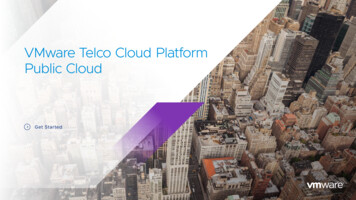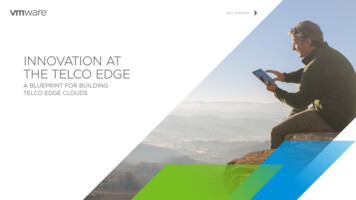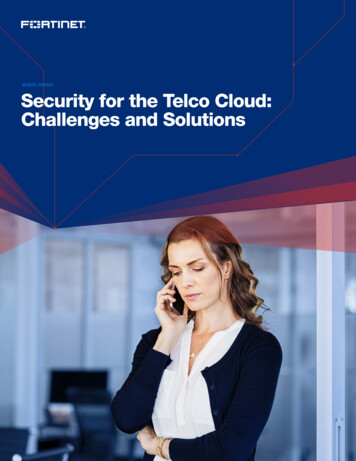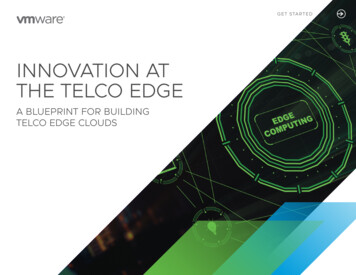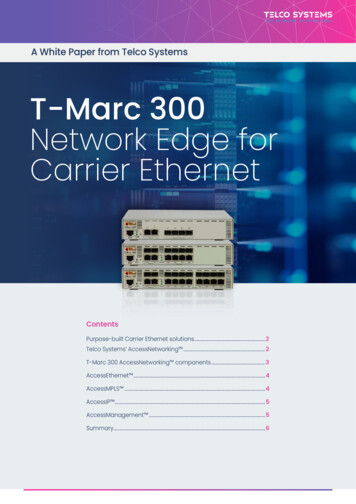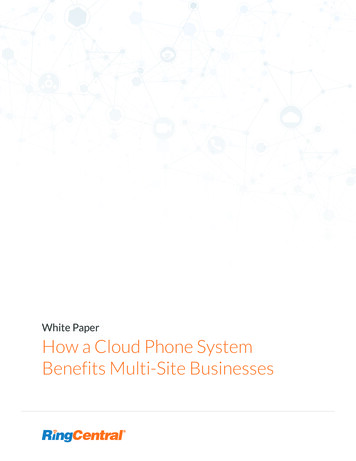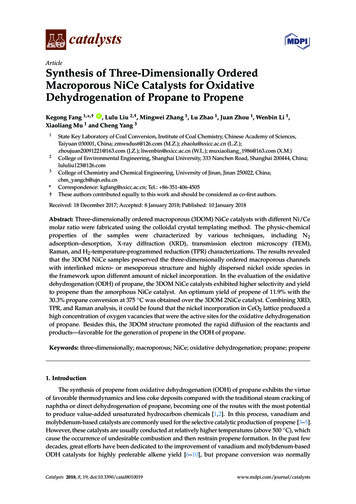
Transcription
Futuriom 5G Catalysts: Telco Cloud and Edge TrendsKey Findings and Highlights 100 B C-band Investment Drives the Real Year of 5G. A er several years of the “Year of5G,” Futuriom believes it’s actually happening in 2021. That’s because communica onsservice providers (CSPs) and cloud providers are making real investments for hundreds ofbillions of dollars in the C-band spectrum to roll out 5G and cloud edge infrastructure tosupport next-genera on wireless applica ons. Top 5G Edge Services. The most promising applica ons and use cases for 5G edge cloudthat will emerge from edge cloud from 2021-2025 include wireless broadband, streamingmedia, cloud gaming, connected vehicles, smart anything (Smart X), immersiveexperiences (VR/AR), Mul -access Edge Compute (MEC) as-a-service, and private wirelessnetworks. Cloud Ecosystems Are Taking Shape and Will Accelerate in 2021. Public cloud providershave stepped up their partnerships with CSPs and technology pla orm vendors.Partnerships among cloud providers, CSPs, and datacenter providers are star ng toaccelerate. Cloud Players Are S ll Favored for Edge. Cloud service providers s ll have the strategicedge and leverage in providing cloud services ranging from IIoT to cloud gaming. In orderto gain market share, CSPs need to focus their mone za on strategies in balance with theright cloud provider partnerships to avoid “dump pipe” strategies. Architecture Catalysts. The arrival of 5G will serve as a catalyst to accelerate networkarchitectures built on technologies such as virtualiza on and microservices. This willbene t providers of so ware virtualiza on technology and exper se from the cloud,as well as technology vendors focused on service automa on, security, and cloud-na vearchitectures. Key 5G Edge Pla orm Features. Cloud technology pla orms are migra ng toward cloudna ve pla orms built on microservices that can provide high connec on density, security,low latency, low power consump on, high bandwidth, and network ititftffitiCloud Market Trend Report
Futuriom 5G Catalysts: Telco Cloud and Edge Trends Top Technology Bene ciaries. Technology areas that will bene t from 5G deploymentinclude public cloud providers, content delivery networks (CDNs), cloud networkingtechnologies, micro datacenters, Internet exchanges, datacenter hos ng providers, smartnetwork interface cards (NICs), edge orchestra on, security providers, op cal fronthaul,op cal backhaul, automa on so ware, edge-compute gear, and edge-data managementso ware. Key 5G Edge Leaders to Watch (Public Companies). Akamai, Amazon, AMD, AT&T, Ciena,Cloud are, Dell, Digital Realty, Equinix, Ericsson, Fastly, Google, IBM, Intel, Microso ,Nokia, HPE, NVIDIA, Qualcomm, T-Mobile, Verizon, and VMware. Key 5G Edge Leaders to Watch (Private Companies). Many of the companies featured inour recent Futurio 40 report have interes ng plays on the cloud edge. Some of theseinclude Alkira, Arrcus, Aryaka, DriveNets, EDJX, In ot, Inten al, Ken k, Saguna Networks,StackPath, Triggermesh, Vapor.io, Versa Networks, Volta Networks, and Weaveworks. Business Challenges. Top concerns in business deployment of 5G services will includeintegra on complexity, cost, exper se in cloud-na ve architectures, service automa on,security, and network availability and resiliency.(Note: Our list of companies is not an exhaus ve list, but a descrip on of compellingtechnology visions collected by Futuriom analysts.)Methodology: Over the course of several months, Futuriom analysts interviewed andsurveyed dozens of service providers, technology providers, and enterprise end users tosynthesize a vision for the new edge cloud. This informa on-gathering process includedcollec ng answers to surveys we sent to more than 30 technology vendors asking for input,some of which is included in this tiftCloud Market Trend Report
Conduct SASEat ScaleStrike the perfectchord with cloudnetworking andsecurity.sdwan.vmware.com
Futuriom 5G Catalysts: Telco Cloud and Edge TrendsTable of Contents1. Introduction2. 5G Capabilities and Platforms: Spectrum and Capabilitiesa) Characteristics and History of the 5G Edgeb) The 3GPP Roadmap & What It Meansc)Spectrum Considerationsd) Latency, the Edge & What It All Means3. Key Catalysts: Top Use Cases for 5G Edge Clouda) Inside the Edge Cloud Ecosystem4. Conclusion and Summary5. Companies to WatchCloud Market Trend Report3
Futuriom 5G Catalysts: Telco Cloud and Edge Trends1. IntroductionAs 5G infrastructure gets deployed and cloud compu ng resources are extended to the edge ofthe network, cloud infrastructure and communica ons networks are becoming increasinglyintegrated and merged, a trend that is likely to con nue with the expansion of 5G deployments.In 2021, deployment is expected to accelerate, demonstrated by the recent hundreds of billionsof dollars in capital being pledged to the rollout of 5G infrastructure and services. In addi on,support from the nancial markets in the form of low interest rates and a recovering economywill contribute to this buildout. The “cloudi ca on” of communica ons networks is gatheringsteam.There has been a fair amount of cau on among CSPs about the deployment of 5G becausereturns were not large in LTE/4G – generally mid-single digits in return on capital. In order tosucceed, CSPs and cloud providers alike will have to generate new high-margin services using 5Ginfrastructure and spectrum. 5G, of course, has been hyped for many years. CSPs have ba led inmarke ng wars while trying to gure out how to deploy billions of dollars in capital that willproduce a return. In Futuriom’s opinion, the marke ng has led the actual technology rolloutbecause everybody has been stalling while they gure out which applica ons and businessservices have the highest poten al to make money. The arrival of the COVID-19 pandemic hasincreased the urgency as organiza ons worldwide recognize the importance of digitalinfrastructure. Recently, CSPs have demonstrated an understanding of this urgency by steppingup capital spending plans as well as striking deals with large cloud service providers for hybridedge services that combine the capabili es of cloud data services with communica onsservices. A detailed overview of these partnerships is provided in Sec on 4.Futuriom believes edge cloud and 5G ac vity and spending will accelerate in 2021 because ofthe following: The macroeconomic rebound, government s mulus, and lower interest rates willsupport aggressive business investment. Recent 5G auc on spending and capital spending plans by both cloud providers andCSPs indicates they are preparing for an accelera on in deployments Technology trends such as digital transforma on and WFA favor edge cloudinfrastructure and services development. Key edge and cloud technologies in the startup community have further maturedand are ready for titififititiCloud Market Trend Report
Futuriom 5G Catalysts: Telco Cloud and Edge TrendsWith this backdrop, it is interes ng that in the fourth year of the “Year of 5G,” strategic planshave shi ed among the CSPs. Whatever you think about the long-term success prospects forCSPs in terms of cloud pro tability, they are crucial to the development of the edge ecosystembecause it won’t happen without a robust public 5G infrastructure. Although private 5Genterprise deployment will be an important market (and the subject of a separate report inApril), Futuriom believes that public 5G deployments will be crucial to leading and catalyzinga wider 5G deployment.With C-band auc on spending exceeding 100 billion and capital spending plans increased bytens of billions, the 5G rollout looks ready to begin in earnest. In addi on, an expansion ofprivate enterprise wireless networks using next-genera on WiFi and unlicensed spectrum suchas CBRS is se ng the stage for a common, wireless infrastructure pla orm that can be used todeploy both public and private communica ons services.All of this infrastructure growth will spur development of the edge infrastructure andecosystem, as CSPs and cloud providers partner to put the cloud and communica ons networkcloser to the customer. This includes upgrades to mobile base sta ons, central o ces, and cloudpoints of presence (PoPs) to deliver advanced 5G infrastructure and build out the virtualizedinfrastructure to support new services and applica ons. This report examines the evolu on ofthis “cloud edge,” and what it will mean for poten al emerging business models.Our analysis shows how the edge is taking shape on the business side, driving and enabling newapplica ons, services, and business models. Large enterprises, organiza ons, and technologycompanies are looking at new poten al services and products aided by the extension of cloudfueled applica ons connected to edge endpoints. It’s important to understand how and whythese might be successful.Futuriom believes that the arrival of 5G has the poten al to change the technology landscapefor many players in a signi cant way. The key is doing so economically, by targe ng the rightservices with the right capabili es and infrastructure. 5G will serve as the catalyst for new cloudcommunica ons infrastructure built on virtualiza on and microservices. The key to its successwill be the uptake of new “edge-enabled” cloud-based applica ons to drive new services andbusiness models. In this report, we will delve into the most promising new edge-enabledservices and applica ons including wireless broadband, streaming media, smart anything(SmartX), retail analy cs, connected vehicles, industrial automa on, public safety, connectedhealthcare, augmented reality, and online ititititittitifttiCloud Market Trend Report
Futuriom 5G Catalysts: Telco Cloud and Edge TrendsThese services will be deployed by partnership among cloud providers, CSPs, and technologyproviders, in strategies we detail in Sec on 4. The grand fear among CSPs is that as they deployhundreds of billions of dollars in 5G edge cloud infrastructure, they remain basic providers ofdumb pipes – albeit with smarter features – and collect a rela vely small amount of the pie inthe form of subscrip on fees. This is what happened in the emergence of the 4G/LTE wave, asthe providers of mobile applica ons, cloud infrastructure, and devices accrued a larger amountof the value and pro ts. So how they enter and de ne these partnerships is crucial, since theyare deploying the bulk of capital for the infrastructure.In our discussion with industry experts, the consensus appears to be that cloud and so wareas-a-service (SaaS) providers s ll hold the upper hand in leverage and use of the infrastructure,with the CSPs facing the more di cult task of deploying and managing it. As an example,Verizon has incurred more than 50 billion in new debt related to 5G infrastructure, but hasguided for only 3%-5% revenue growth over the next few years. Many larger CSPs have mademoves to diversify into services such as streaming media, but they will have to do be er bytaking advantage of advanced 5G services in ver cal markets and IoT in order to rewardshareholders for their large outlays.For this report, Futuriom interviewed and surveyed dozens of service providers, technologyproviders, and enterprise end users to compile this vision. We also combed through informa onon trends from the Futuriom.com website, news reports, and market releases.Included here are our conclusions about the poten al emerging business opportuni es on theedge that will be enabled by 5G. We also outline key use cases and various technologyapproaches to edge deployments. Finally, the report also pro les emerging technologycompanies and solu ons in the end-to-end edge compute ecosystem and discusses the businesschallenges presented by this new market.[Editor’s note: Futuriom has dug deeply into the cloud edge. We are publishing two reports onthe topic – this report, 5G Catalysts: Telco Cloud and Edge Trends (March/April 2021), as well asa second report, 5G Private Wireless (April 2021). This report focuses on emergence of thepublic communica ons edge cloud, while the 5G Private Wireless report will focus on privateenterprise applica ons for 5G.]tifttttitifitifi6titiffitititifitititiCloud Market Trend Report
Futuriom 5G Catalysts: Telco Cloud and Edge Trends2. 5G Capabilities and Platforms: Spectrum and CapabilitiesThe development of the cloud edge touches a wide range of industries and technologies, butthe most crucial aspect is that it will be enabled by the new wave of 5G wireless infrastructurethat has several important characteris cs: 5G infrastructure has a wide range of spectrum features stretching from URLLC to cloudvirtualiza on, with improvements including increased bandwidth, be er latency, andmore exible cloud-based management. This will massively expand the market forpoten al applica ons and services.The next-genera on wireless infrastructure is the rst to be based on cloud-na vedesign principles and virtualiza on, fostering integra on with a wide range of cloudservices – as well as introducing techniques for ne tuning applica on access andperformance using network slicing.5G infrastructure will be more open and “disaggregated,” enabling a faster deploymentof infrastructure including into new markets such as enterprise private wireless.Characteris cs and History of the 5G EdgeThere are many debates about what the edge cloud will look like once 5G infrastructure isconnected to the wider range of public cloud and enterprises. The underlying infrastructure for5G is guided by a speci c set of technology standards generated by the 3GPP standardspartnership.The infrastructure being built at the edge to connect users, devices, and networks will be key toall the new services and applica ons. The 5G infrastructure represents a large shi from 4G/LTE,which was largely built with proprietary, non-virtualized infrastructure. 5G infrastructure will bebuilt on the same technology common to cloud-na ve pla orms, which will make cloud serviceintegra on much easier.In the public communica ons infrastructure, CSPs worldwide ini ally deployed 5G in the NonStandalone (NSA) mode, in which the 5GNR technology was overlaid on the exis ng 4G/LTEcore network and radio access network (RAN). NSA allows CSPs to launch enhanced MobileBroadband (eMBB) services to deliver 5G data speeds and boost capacity, while leveraging theirexis ng 4G/LTE infrastructure assets. While the higher broadband speeds enable improvedexperiences around video streaming, AR, cloud gaming, and other immersive applica ons, NSAdoesn’t support network slicing, massive Machine-Type Communica ons (mMTC), or ititifltiCloud Market Trend Report
Futuriom 5G Catalysts: Telco Cloud and Edge TrendsAlso, if the network can’t nd a stable 5G signal, it will push that connec on to 4G, whichintroduces addi onal latency into the network.Many edge compute applica ons and services operate just ne without 5G. In the industrialsegment, for example, low-power wide-area networking protocols like Long Range Wide AreaNetwork (LoRaWAN), Bluetooth Low Energy (BLE), Narrowband IoT (NB-IoT), and many othersare rou nely deployed for IoT use cases with rela vely low bandwidth requirements. Similarly,WiFi and 4G/LTE are typically used for connec vity to video cameras as well as for manyapplica ons in AR and online gaming.Edge applica ons with high connec on density will require 5G. A 4G Low Power Wide Area(LPWA) network can typically support up to 70,000 ac ve connected devices per squarekilometer. As IoT sensors and personal devices, including wearables, proliferate, this maximumconnec on density will become a signi cant limita on. The IMT-2020 standard, which de nesthe technical speci ca ons of 5G, outlines a minimum connec on density of one million devicesper square kilometer, a 14x increase compared to 4G. 5G will therefore be cri cal for highdensity IoT use cases.The low latency provided by 5G will enable new classes of edge applica ons that bene t fromsingle-digit millisecond latency, an order of magnitude improvement over 4G. Factory- oorrobots, for example, will be connected to local edge compute resources over a 5G network tocoordinate their ac ons and avoid running into each other. Similarly, drones will leverage lowlatency 5G links to edge compute base sta ons so that object recogni on for naviga on can beperformed on the ground, avoiding the need for a heavy computer and ba ery on the droneitself. Importantly, 5G networks will be able to guarantee a speci c latency, so that round-tripnetwork transit delays are fully determinis c. This determinism will be cri cal for use cases suchas synchronizing the high-speed opera on of mul ple robots or ensuring a consistent userexperience with immersive AR.The high bandwidth delivered by 5G networks is a result of the 5GNR air interface, which usesmuch higher radio frequencies than 4G (up to 28 GHz, compared to between 700 MHz and 2.5GHz). This enables 5G to transfer exponen ally more data than 4G, with carriers forecas ngdata rates as high as 10 Gbps to 20 Gbps. 5G also leverages a new radio technology calledMassive MIMO (Mul ple Input, Mul ple Output), which uses mul ple targeted beams tospotlight and follow users around a cell site, thereby improving coverage, speed, and capacity.Ini al 5G deployments involve installing 5GNR with Massive MIMO running on top of theexis ng 4G infrastructure, referred to as the Non-Standalone (NSA) ititi8titifititititifititifititititititititiCloud Market Trend Report
The high bandwidth of 5G will be a key enabler for a wide range of new and improved edge usecases based on streaming video, autonomous vehicles, real- me analy cs, and truly hap capplica ons in robo cs, mines, and the much-hyped remote surgery.5G network slicing enables a single physical network to be par oned into mul ple virtualnetworks, each op mized for the di erent needs of speci c users, whether those users areconsumers or machines. Since the slices are isolated from each other in the control and userplanes, each individual user experiences their network as if it were a dedicated physicalnetwork. A network operator, who might be a carrier owning a public network or an enterprisewith a private network, can deploy only the func ons required to support a par cular customeror market segment, resul ng in signi cant cost savings compared to deploying full func onalityto devices that will only use a subset of those func ons. Within a single 5G network, forexample, network slicing could provision a highly available, highly secure, low-bandwidth slicefor an IoT applica on like a cluster of smart meters in parallel with a high-throughput, lowlatency slice for an AR service. Network slicing will enable an edge compute pla orm to coste ec vely and e ciently support the needs of a widely diverse range of users, even as thoseneeds change dynamically.As outlined above, fundamental proper es of 5G such as high connec on density, low latency,high bandwidth, and network slicing are catalysts for new edge applica ons and will enable newbusiness models. The next sec on explores speci c edge use cases that require 5G technology.In the longer term, CSPs are migra ng to Standalone (SA) 5G deployments, which will fullyunlock the power and promise of 5G technology. Based on a cloud-na ve 5G packet corearchitecture along with the new 5G RAN, SA deployments will introduce network slicing, mMTC,and URLLC. SA will enable a wider range of use cases than NSA while improving opera onale ciency and reducing costs for CSPs.The 3GPP Roadmap & What It MeansThe 3GPP is the standards group that creates the mobile industry roadmap. The most recentroadmap sets out guidelines for the features and capabili es that will be available with 5G. Thegure below summarizes key features of the latest 3GPP release, and maps those features tokey a ributes that will be required to support growth in private wireless fifftitititititiffititttiffCloud Market Trend ReportffifiFuturiom 5G Catalysts: Telco Cloud and Edge Trends
Futuriom 5G Catalysts: Telco Cloud and Edge TrendsFeatures addressed in Release 16 provide guidance on how to overcome many of the hurdlesfacing private wireless network adop on at scale. Each of these challenges are addressed inRelease 16, with further work and re nements expected to be addressed by Release 17, whichare expected to be nalized In late2021.fitifiCloud Market Trend Report10
Futuriom 5G Catalysts: Telco Cloud and Edge TrendsSpectrum Considera onsThe most signi cant market factor in the widespread penetra on of 5G and by extension privatewireless network growth is spectrum availability. For most folks familiar with the 5G market, theneed for more and varied spectrum op ons compared to previous wireless technologygenera ons is well known. In short, the capacity needed to sa sfy 5G data rates, and thedensity of devices that will operate on a 5G network make it necessary to tap into a broaderarray of spectrum resources than have typically been available for 4G, 3G, etc.5G operates on three di erent spectrum bands. While the speci c band used for an individualconnec on is generally transparent to an end-user, there are important tradeo s in terms ofwhich band is best suited to di erent categories of edge applica ons.As such, spectrum resources in low-band, mid-band, and high-band frequency ranges areexpected to be supported by 5G equipment manufacturers. Broad guidelines for each spectrumband can be de ned as follows: Low-band: 1 GHz and below Mid-band: Between 1 GHz and 6 GHz High-band: Above 24 GHzWhile the 3GPP recommends suppor ng opera ons in all three categories, and several subcategories within each band, country and/or regional policy preferences/constraints, as well asthe product development strategies of equipment suppliers, will dictate which bands will beu lized more heavily than others.Low-band 5G is typically spectrum below 1 GHz that is primarily used today by US carriers for3G and LTE. This low-band spectrum provides a very wide coverage area with good buildingpenetra on, but peak data speeds top out at 100 Mbps. This spectrum is becomingdiscon nued for 3G and reclaimed for 5G. One low band (600 MHz-700 MHz) tower can coverhundreds of square miles with 5G service.Edge use cases with moderate bandwidth requirements and/or those that involve high mobility,like in-vehicle infotainment and naviga on, will primarily use low-band 5G spectrum because ofthe high coverage and reduced rate of hand-o s between cells. In addi on, wide-areaapplica ons and in-building deployments are likely to use lower-band titititiCloud Market Trend Report
Futuriom 5G Catalysts: Telco Cloud and Edge TrendsMid-band 5G spectrum between 1 GHz and 6 GHz provides faster throughput and lower latencythan low-band. Mid-band transmissions are less suitable for a good in-building penetra on, butpeak speeds can reach as high as 1 Gbps. Massive MIMO (Mul ple Input, Mul ple Output)technology can be used to enhance penetra on and coverage areas with this spectrum,grouping several antennas into a single box at one cell tower and crea ng mul ple beams tomany di erent users simultaneously. T-Mobile is promo ng this technology to extend coverage.A mid-band tower provides 5G service over a radius of several square miles.O ering a balance between high bandwidth and wide coverage, mid-band 5G is expected to beused for low-latency edge use cases such as URLLC for cri cal IoT applica ons or control ofdrones. With be er wide-area and indoor coverage than high-band, the mid-band spectrum isan op mal compromise between coverage, quality, throughput, capacity, and latency.mmWave, or high-band 5G spectrum from 24 GHz, to 100 GHz enables speeds of up to tens ofGbps at extremely low latency. However, mmWave coverage areas are limited and buildingpenetra on is very poor, though major equipment companies are focused on overcoming thesepropaga on challenges since mmWave is fundamental to achieving 5G’s speed and latencytargets. For mmWave mobile devices to work, both the cell tower and the mobile device mustuse new antenna technology capable of dynamically steering and forming the radio beam toand from the cell tower. A mmWave tower covers a radius of one mile or less. mmWave 5G willbe deployed using “small cells”: low-powered radio access nodes that provide service to bothindoor and outdoor areas. These nodes can work in either licensed or unlicensed spectrum,with a range up to one mile. mmWave 5G is ideally suited to line-of-sight edge computeapplica ons that require ultra-high bandwidth.In addi on to a variety of bands to carry signals, dis nc ons between licensed and unlicensedspectrum have taken on a more prominent role in 5G and private wireless strategy planning.This includes the interplay of 5G, CBRS, and WiFi, which are all going to be increasinglyintegrated to deliver private wireless capabili es for enterprises.North America in par cular has recently shown some interes ng shi s, as the major U.S.providers, including AT&T and Verizon, have shi ed focus to C-band spectrum (generally de nedas 3.4GHz and 42. GHz), which should have the right mix of bandwidth and reach. Previousopera ons focused on millimeter wave (mmWave) spectrum, which provides high bandwidth atshort reach to target xed wireless broadband, have been modest but do not provide a widerange of applica ons for edge cloud. Indeed, rollouts in the mmWave category have beenunderwhelming, only targe ng subscribers in the mid-single-digit ttifftitititititiffCloud Market Trend Report
Futuriom 5G Catalysts: Telco Cloud and Edge TrendsFollowing are a few details on some of the recent investment plans given by the North Americanoperators:— AT&T (T) acquired 80 MHz of spectrum for 27.4 billion in the FCC’s auc on. It plans to spendbetween 6 billion and 8 billion between now and 2024 on deploying the rst 40 MHz of itsnewly acquired resources, equipping between 70 million and 75 million points of presence(PoPs) by the end of 2022. In 2021, AT&T will extend its broadband ber footprint to over 90metros, serving 3 million new customers. All this spend is already included in AT&T’s 18 billionprojected capex for 2021. AT&T plans to pay back 23 billion of its spectrum bill this year fromits available cash.— T-Mobile US (T-MUS), which acquired 40 MHz of spectrum for 10.5 billion, an cipatesspending between 11.7 billion and 12 billion in 2021 on capex, including 5G. By the end of2023, the carrier plans to have its 5G network infrastructure completed and ready to deploy allof its spectrum alloca on. T-Mobile also boasts that due to its modest spending on spectrum(the least of the three leading carriers), it won’t have to struggle with payback or capex toaccommodate growth. Indeed, the company plans for a 60 billion buyback of stock between2023 and 2025.— Verizon (VZ) acquired the most spectrum of all buyers — 161 MHz, for which it paid 52.9billion. The carrier expects to spend 10 billion above its ordinary capex annually for the nextthree years. (Projected capex before those extra charges was originally between 17.5 and 18.5 billion for 2021.) Verizon plans to add 5G in 46 markets serving 100 million people overthe next 12 months. By 2024, coverage will increase to 250 million people. Verizon expects newservices to fund the payback on spectrum, via revenue increases of 2% or more in 2021,growing to 4% by 2024.So far, all the proposed spending will be a spike for the top carriers this year, though not thebiggest in recent mes. AT&T, for instance, spent heavily in 2017 and 2018 on ber and itsFirstNet rst responder network, compared to what it spent last year. And T-Mobile investedheavily in 5G and was able to include numbers from the Sprint merger, making 2020 a standoutcapex year, as indicated in the chart on the next page:tififiti13fititifiCloud Market Trend Report
Futuriom 5G Catalysts: Telco Cloud and Edge TrendsCarriers di er in their emphasis on new markets driven by 5G. But AT&T and Verizon havestressed the importance of the network edge. And in both cases, execu ves said ecosystempartnerships, including ones with cloud providers, will be key to addressing enterprise demandfor edge resources.“We will con nue to expand our 5G edge solu ons in 2021, developing customer-ledapplica ons with technology partners like Microso , IBM, Accenture, Google and Deloi e,” saidJe ery Sco McElfresh, CEO of AT&T Communica ons LLC, which owns the wireless andbroadband assets of the rm, during the AT&T Analyst and Investor Day event on March 12,2021. All these players are part of trials in which AT&T is pairing its edge infrastructure withcloud services.Verizon also emphasized its Intelligent Edge services via MEC as key to successful 5G. During thecarrier’s Virtual Investor Day on March 10, Kyle Malady, Verizon’s EVP and CTO, stated:“Last year, we were the rst in the world to deploy a public MEC [mul -accessedge compute] solu on with AWS. We deployed 10 zones in 2020 and will deployan addi onal 10 this year. We an cipate that C-band will accelerate MECadop on. In addi on, we will start private MEC deployments in partnership withMicroso that feature 5G in-building solu loud Market Trend Report
Futuriom 5G Catalysts: Telco Cloud and Edge TrendsTo reach a broader market, CSPs as well as enterprises are targe ng more exible 5G spectrum,including the C-band as well as CBRS. The U.S. CSPs have now invested billions in C-bandspectrum, which is in
to gain market share, CSPs need to focus their moneHzaHon strategies in balance with the right cloud provider partnerships to avoid "dump pipe" strategies. Architecture Catalysts. The arrival of 5G will serve as a catalyst to accelerate network architectures built on technologies such as virtualizaHon and microservices. This will
